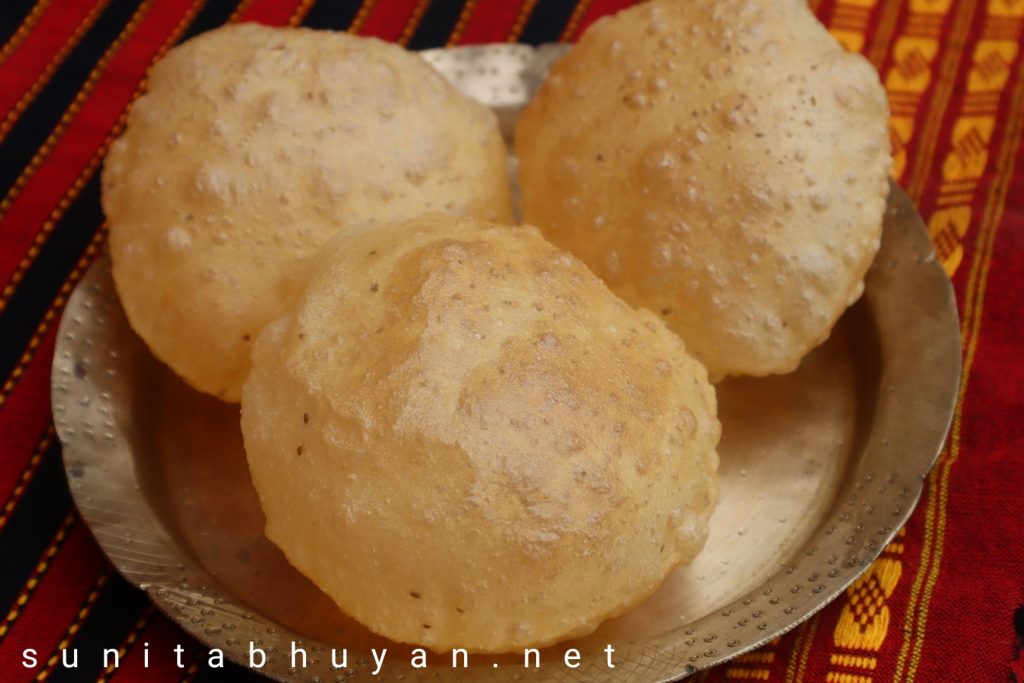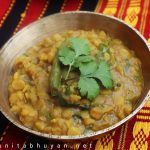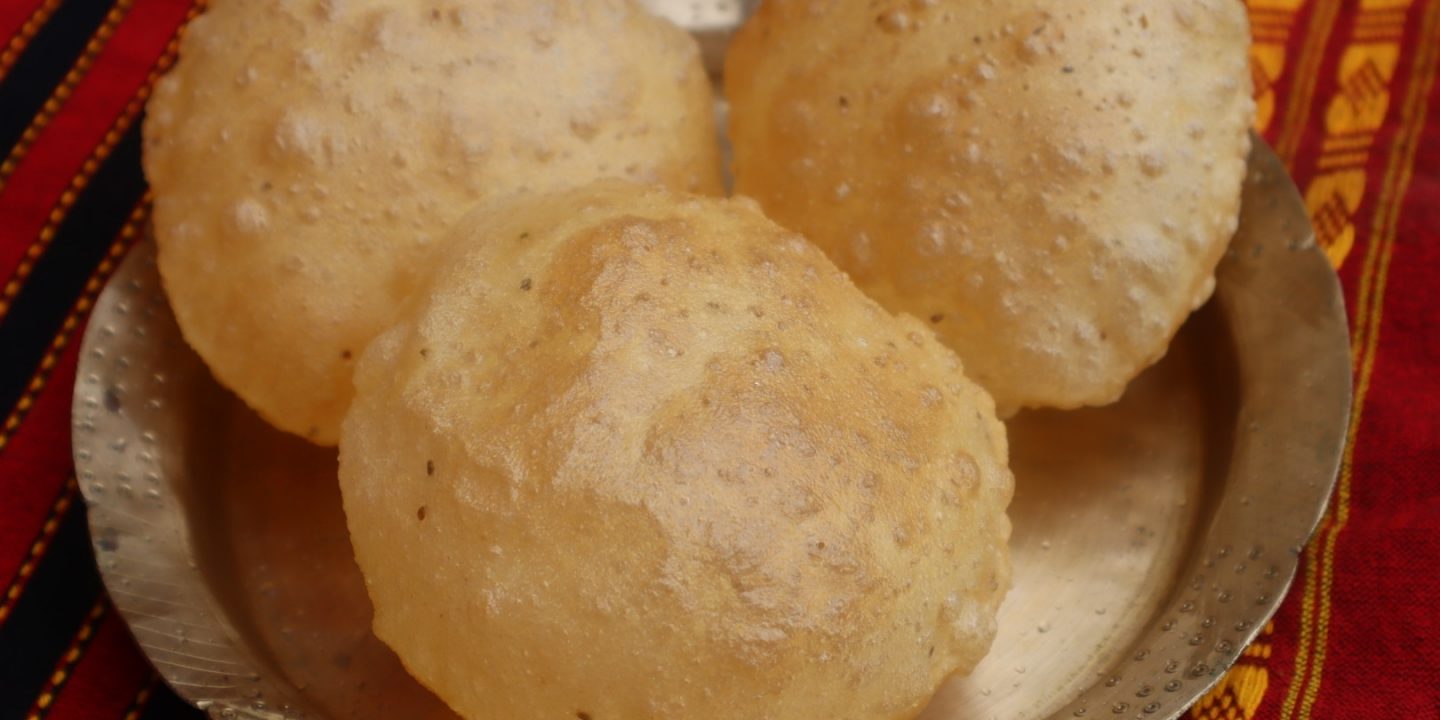Sharing this luci /poori recipe; I had made these recently to accompany some bootor dali (Assamese style split chickpeas curry). Flaky, puffed up luci / poori are a delight, so here’s a recipe for you to try.
Luci? Poori?
Luci (pronounced loo-sie) / poori is a deep fried Indian bread made with unleavened dough. The dough is divided into small portions which are then rolled into small discs and deep fried in hot oil to puff up. The word ‘luci’ is what we call the popular ‘poori’ in Assam, my birthplace. Growing up, luci’s were mostly made with plain flour. A mix of whole wheat and plain flour was also used. I, however, prefer to use just whole wheat flour (atta) which adds a nutty flavour.

These beauties are deep fried, so they are not made very often in our home nowadays. But when they are, they are a true indulgence. Amazing how we change with time. Growing up, back in Assam, luci was a part of life. Festival time (and there were innumerable ones throughout the year)- make luci; any special family celebration- make luci; any special guests- make luci. Or for that matter, no special occasion or event, but still want to have some, let’s knead some dough; to make luci of course.
Whether they are paired with something as simple as a potato fry or a spicy and rich curry like chicken or mutton, these small puffed up, deep fried Indian breads are an indulgence.

There is something special about having a hot, just off the pan luci, flaky and puffed up in all its glory. When I was young, I remember being mesmerised with these small balls of dough which were rolled and kept side. The minute they hit the oil, something magical happened and it would puff up like a balloon.
The term ‘gorom gorom phula luci’ (hot puffed luci) still rings in my ear. The rolled out dough was kept covered until just before being served. And they would be fried and served immediately. So, usually more than a pair of hands would be involved. Sometimes, it would be a production line of three- one rolling the balls of dough, one frying and the other serving the freshly made lucis before they lose their puff.
Though lucis puff up like baloons, they do tend to deflate after a while. It still tastes good, but definitely not quite the same. They are best had when still puffed up. You need to poke / press it carefully as the steam will gush out. How many greedy souls have burnt their fingers trying to poke them too quickly. The trick is to let go of the steam gradually and then wrap pieces of the luci around whatever was made to accompany it.

A ball of dough is rolled out into small discs, slid into hot oil and as if by magic, puffs up to form a flaky, puffy bread. Really quite fascinating and sounds simple. However, those who are familiar with making luci / poori will know well that for this magic to happen, there are a few dos and don’ts and any bit of rolled out dough disc will not create magic in the hot oil. Below, I share my recipe and tips for puffy, flaky luci / poori. If you are new to Indian cuisine or have just ventured into cooking, this will be helpful.
A few tips-
The dough-
- Rub the fat into the flour well. After a while, a small portion pressed together should hold its shape.
- Add the water gradually to knead the dough. Too much or too less water will lead to either a wet or craggy dough- both will prevent the luci from puffing.
- Keep any unused dough covered at all times to prevent drying; this includes any balls of dough ready to be rolled. Keep them covered until you roll.
The oil
- The oil for frying needs to be hot but not smoking hot. An old fashioned test that still works for me every time- drop a very tiny ball of dough into the hot oil. If it rises to the surface immediately and doesn’t brown, the oil is ready for frying. If it is slower to come to the top, the oil is not hot enough; if the ball of dough browns quickly, the oil is too hot. If the oil is too hot, reduce the heat and wait for a while to cool before frying. On the other hand if the oil is not hot enough, the luci will not puff up and will be hard. So regulate the heat accordingly.
Rolling
- Do not roll them too thick or too thin or they won’t puff up.
Frying
- Once a rolled out luci is in the hot oil, do not touch till it starts to come up to the surface. Before it does so completely, press it down into the oil until completely puffed up.
- Before removing the fried luci from the pan, hold the puffed luci against the pan for a few seconds for the excess oil to slide off.
- Transfer the luci to a tray lined with paper towels to drain off any excess oil.
We recently enjoyed our luci /poori with some bootor dali / Assamese style split chickpea dal. Find the recipe for bootor dali below.

Please continue to read for the full luci / poori recipe further below. Check out the video too. Enjoy!
Subscribe to Sunita’s World – life and food! to receive updates on latest posts, tips and recommendations straight to your inbox! Simply fill in the details below. Thank you!
Recipe card-

Luci / Poori
Ingredients
- 3 cups plain whole wheat flour (atta)
- 1 tsp salt
- 1 tsp carom seeds (ajwain)- optional
- ¼ cup oil
- 1 cup water (may need more or less)
- oil for deep frying
Instructions
- In a bowl add the flour, salt, carom seeds and 1/4 C oil.
- Rub everything together for a few minutes. A portion of the long sausage shape mixture when pressed together in your palm should hold its shape.
- Add water gradually and knead to make a dough (neither too soft or too craggy).
- Add only as much water as needed. You may or my not need the whole cup of water.
- Cover and rest for 30 minutes.
- Divide the dough into two portions. Cover one portion.
- Roll out the uncovered portion of dough into a long sausage shape and divide into equal portions. Roll and flatten each portion between your palms and keep covered for later. Repeat with the other portion of dough. Keep all the portions (makes 16) covered until needed.
- Heat a pan with oil for deep frying.
- Lightly grease a portion of the dough and roll out into discs; neither too thick or thin.
- Roll out few discs at a time. Keep them covered but do not stack them.
- Check the oil is ready.
- Drop a very tiny ball of dough into the hot oil. If it rises to the surface immediately and doesn't brown, the oil is ready for frying. If the oil is too hot, reduce the heat and wait for a while to cool before frying.
- Gently lower a rolled out disc into the hot oil.
- Wait for it to rise to the surface. When it is halfway, gently press it down into the oil until it is puffed up.
- Flip and cook on the other side. Once the luci is puffed up and flipped over , it can be taken out . We like ours with a bit more colour so keep it for longer.
- Transfer the fried luci onto a tray lined with paper towels.
- Serve hot with a side dish.
Video
You can find other Assamese recipes on my blog here.
Until next time,
Sunita
STAY CONNECTED:
